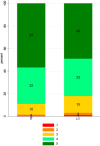Benchmarking experience to improve paediatric healthcare: listening to the voices of families from two European Children's University Hospitals
- PMID: 33504331
- PMCID: PMC7839229
- DOI: 10.1186/s12913-021-06094-z
Benchmarking experience to improve paediatric healthcare: listening to the voices of families from two European Children's University Hospitals
Abstract
Background: Patient Reported Experience Measures (PREMs) are recognized as an important indicator of high quality care and person-centeredness. PREMs are increasingly adopted for paediatric care, but there is little published evidence on how to administer, collect, and report paediatric PREMs at scale.
Methods: This paper describes the development of a PREMs questionnaire and administration system for the Meyer Children's University Hospital in Florence (Meyer) and the Children's Clinical University Hospital in Riga (CCUH). The system continuously recruits participants into the electronic administration model, with surveys completed by caregivers or adolescents at their convenience, post-discharge. We analyse 1661 responses from Meyer and 6585 from CCUH, collected from 1st December 2018 to 21st January 2020. Quantitative and qualitative experience analyses are included, using Pearson chi-square tests, Fisher's exact tests and narrative evidence from free text responses.
Results: The large populations reached in both countries suggest the continuous, digital collection of paediatric PREMs described is feasible for collecting paediatric PREMs at scale. Overall response rates were 59% in Meyer and 45% in CCUH. There was very low variation in mean scores between the hospitals, with greater clustering of Likert scores around the mean in CCUH and a wider spread in Meyer for a number of items. The significant majority of responses represent the carers' point of view or the perspective of children and adolescents expressed through proxy reporting by carers.
Conclusions: Very similar reported scores may reflect broadly shared preferences among children, adolescents and carers in the two countries, and the ability of both hospitals in this study to meet their expectations. The model has several interesting features: inclusion of a narrative element; electronic administration and completion after discharge from hospital, with high completion rates and easy data management; access for staff and researchers through an online platform, with real time analysis and visualization; dual implementation in two sites in different settings, with comparison and shared learning. These bring new opportunities for the utilization of PREMs for more person-centered and better quality care, although further research is needed in order to access direct reporting by children and adolescents.
Keywords: Benchmarking; Paediatric care; Patient reported experience measures.
Conflict of interest statement
IC and KJG are employed as researchers by the MeS Lab. FM is a Medical Director at Meyer Hospital. VA is General Director of CCUH.
Figures
References
MeSH terms
LinkOut - more resources
Full Text Sources
Other Literature Sources




